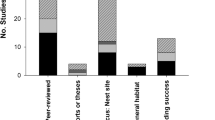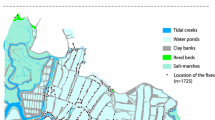Abstract
How breeding birds distribute in relation to landscape-scale habitat features has important implications for conservation because those features may constrain habitat suitability. Furthermore, knowledge of these associations can help build models to improve area-wide demographic estimates or to develop a sampling stratification for research and monitoring. This is particularly important for rare species that have uneven distributions across vast areas, such as the federally listed piping plover (Charadrius melodus; hereafter plover). We examined how remotely-sensed landscape features influenced the distribution of breeding plover pairs among 2-km shoreline segments during 2006–2009 at Lake Sakakawea in North Dakota, USA. We found strong associations between remotely-sensed landscape features and plover abundance and distribution (R2 = 0.65). Plovers were nearly absent from segments with bluffs (>25 m elevation increase within 250 m of shoreline). Relative plover density (pairs/ha) was markedly greater on islands (4.84 ± 1.22 SE) than on mainlands (0.85 ± 0.17 SE). Pair numbers increased with abundance of nesting habitat (unvegetated-flat areas \({\hat{\beta }} = 0.28 \pm 0.08\,{\text{SE}}\)). On islands, pair numbers also increased with the relative proportion of the total area that was habitat (\({\hat{\beta }} = 3.27 \, \pm \, 0.46\,{\text{SE}}\)). Our model could be adapted to estimate the breeding population of plovers or to make predictions that provide a basis for stratification and design of future surveys. Knowledge of landscape features, such as bluffs, that exclude use by birds refines habitat suitability and facilitates more accurate estimates of habitat and population abundance, by decreasing the size of the sampling universe. Furthermore, techniques demonstrated here are applicable to other vast areas where birds breed in sparse or uneven densities.





Similar content being viewed by others
References
Amat JA, Fraga RM, Arroyo GM (1999) Replacement clutches by Kentish plovers. Condor 101:746–751
Anteau MJ (2012) Do interactions of land use and climate affect productivity of waterbirds and prairie-pothole wetlands? Wetlands 32:1–9
Anteau MJ, Shaffer TL, Sherfy MH, Sovada MA, Stucker JH, Wiltermuth MT (2012a) Nest survival of piping plovers at a dynamic reservoir indicates an ecological trap for a threatened population. Oecologia 170:1167–1179
Anteau MJ, Sherfy MH, Wiltermuth MT (2012b) Selection indicates preference in diverse habitats: a ground-nesting bird (Charadrius melodus) using reservoir shoreline. PLoS One 7:e30347
Anteau MJ, Wiltermuth MT, Sherfy MH, Shaffer TL (2014a) Measuring and predicting abundance and dynamics of habitat for piping plovers on a large reservoir. Ecol Model 272:16–27
Anteau MJ, Wiltermuth MT, Sherfy MH, Shaffer TL, Pearse AT (2014b) The role of landscape features and density dependence in growth and fledging rates of piping plovers in North Dakota, USA. Condor Ornithol Appl 116:195–204
Arnold TW (2010) Uninformative parameters and model selection using Akaike’s information criterion. J Wildl Manag 74:1175–1178
Burger J (1987) Physical and social determinants of nest-site selection in piping plover in New Jersey. Condor 89:811–818
Catlin DH (2009) Population dynamics of piping plovers (Charadrius melodus) on the Missouri River. PhD Dissertation, Virginia Polytechnic Institute and State University, Blacksburg, Virginia
Catlin DH, Jacobson RB, Sherfy MH, Anteau MJ, Felio J, Fraser JD, Lott C, Shaffer TL, Stucker JH (2011) Discussion of “Natural hydrograph of the Missouri River near Sioux City and the Least Tern and Piping Plover” by Donald Jorgensen. J Hydrol Eng 15:1076–1078
Christman MC (2004) Sequential sampling for rare and geographically clustered populations. In: Thompson WL (ed) Sampling rare or elusive species. Island Press, Washington DC, pp 134–145
Clark RG, Shutler D (1999) Avian habitat selection: pattern from process in nest-site use by ducks? Ecology 80:272–287
Cowardin LM, Shaffer TL, Arnold PM (1995) Evaluations of duck habitat and estimation of duck population sizes with a remote-sensing-based system. U.S. Department of the Interior, National Biological Service, Washington, DC
Donner DM, Probst JR, Ribic CA (2008) Influence of habitat amount, arrangement, and use on population trend estimates of male Kirtland’s warblers. Landscape Ecol 23:467–480
Elias SP, Fraser JD, Buckley PA (2000) Piping plover brood foraging ecology on New York Barrier Islands. J Wildl Manage 64:346–354
Elliott-Smith E, Haig SM (2004) Piping plover (Charadrius melodus). In: Poole A (ed) The birds of North America online. Cornell Lab of Ornithology, Ithaca, New York
Espie RHM, Brigham RM, James PC (1996) Habitat selection and clutch fate of piping plovers (Charadrius melodus) breeding at Lake Diefenbaker, Saskatchewan. Can J Zool 74:1069–1075
Frink CR (1991) Estimating nutrient exports to estuaries. J Environ Qual 20:717–724
Gotelli NJ (1995) A primer of ecology. Sinauer Associates Inc, Sunderland, Massachusetts
Haffner CD, Cuthbert FJ, Arnold TW (2009) Space use by Great Lakes piping plovers during the breeding season. J Field Ornithol 80:270–279
Harris WC, Duncan DC, Franken RJ, McKinnon DT, Dundas HA (2005) Reproductive success of piping plovers at Big Quill Lake, Saskatchewan. Wilson Bull 117:165–171
Hays H, LeCroy M (1971) Field criteria for determining incubation stage in eggs of the common tern. Wilson Bull 83:425–429
Horning N, Robinson JA, Sterling EJ, Turner W, Spector S (2010) Remote sensing for ecology and conservation: a handbook of techniques. Oxford University Press, Oxford, New York
Institute SAS (2002) SAS/STAT user’s guide, version 9. SAS Institute, Cary, NC, USA
Johnson DH (1980) The comparison of usage and availability measurements for evaluating resource preference. Ecology 61:65–71
Johnson DH, Gibbs JP, Herzog M, Lor S, Niemuth ND, Ribic CA, Seamans M, Shaffer TL, Shriver WG, Stehman SV, Thompson WL (2009) A sampling design framework for monitoring secretive marshbirds. Waterbirds 32:203–215
Jones J, Robertson RJ (2001) Territory and nest-site selection of Cerulean warblers in eastern Ontario. Auk 118:727–735
Kaminski RM, Gluesing EA (1987) Density-related and habitat-related recruitment in mallards. J Wildl Manag 51:141–148
Knetter JM, Lutz RS, Cary JR, Murphy RK (2002) A multi-scale investigation of piping plover productivity on Great Plains alkali lakes, 1994–2000. Wildl Soc Bull 30:683–694
Kruse CD, Higgins KF, Vander Lee BA (2001) Influence of predation on piping plover, Charadrius melodus, and least tern, Sterna antillarum, productivity along the Missouri River in South Dakota. Can Field Nat 115:480–486
Loegering JP, Fraser JD (1995) Factors affecting piping plover chick survival in different brood-rearing habitats. J Wildl Manag 59:646–655
Maxson SJ, Haws KV (2000) Population studies of piping plovers at Lake of the Woods, Minnesota: 19 year history of a declining population. Waterbirds 23:475–481
Miranda LE (2008) Extending the scale of reservoir management. Am Fish Soc Symp 62:1–28
Montevecchi WA (1978) Nest site selection and its survival value among laughing gulls. Behav Ecol Sociobiol 4:143–161
Murphy RK, Michaud IMG, Prescott DRC, Ivan JS, Anderson BJ, French-Pombier ML (2003) Predation on adult piping plovers at predator exclosure cages. Waterbirds 26:150–155
Poon EL, Margules CR (2004) Searching for new populations of rare plant species in remote locations. In: Thompson WL (ed) Sampling rare or elusive species. Island Press, Washington, DC, pp 189–207
Powell AN, Cuthbert FJ (1992) Habitat and reproductive success of piping plovers nesting on Great Lakes islands. Wilson Bull 104:155–161
Prach K, Pysek P, Smilauer P (1993) On the rate of succession. Oikos 66:343–346
Prindiville Gaines EM, Ryan MR (1988) Piping plover habitat use and reproductive success in North Dakota. J Wildl Manag 52:266–273
Roudybush E, Grau CR, Petersen MR, Ainley DG, Hirsch KV, Gilman AP, Patten SM (1979) Yolk formation in some Charadriform birds. Condor 81:293–298
Shaffer TL, Johnson DG (2008) Ways of learning: observational studies versus experiments. J Wildl Manag 72:4–13
Shaffer TL, Sherfy MH, Anteau MJ, Stucker JH, Sovada MA, Roche EA, Wiltermuth MT, Buhl TK, Dovichin CM (2013) Accuracy of the Missouri River least tern and piping plover monitoring program: considerations for the future. U.S. Geological Survey Open File Report 2013-1176
Sherfy MH, Stucker JH, Anteau MJ (2008) Missouri River emergent sandbar habitat monitoring plan: a conceptual framework for adaptive management. U.S. Geological Survey, 2008–1223
Thompson WL, White GC, Gowan C (1998) Monitoring vertebrate populations. Academic Press Inc, San Diego, California, USA
U.S. Fish and Wildlife Service (2003) U.S. Fish and Wildlife Service 2003 amendment to the 2000 Biological Opinion on the Missouri River main stem reservoir system, operation and maintenance of the Missouri River bank stabilization and navigation project, and operation of the Kansas River reservoir system. U.S. Fish and Wildlife Service, Washington, DC. http://www.nwo.usace.army.mil/html/pm-c/Files/2003AmendmentTo2000BiOp.pdf
U.S. Fish and Wildlife Service (2013) Waterfowl population status, 2013. U.S. Department of the Interior, Washington, DC, USA
Wiltermuth MT, Anteau MJ, Sherfy MH, Pearse AT (2014) Habitat selection and movements by piping plover broods suggest a tradeoff between breeding stages (in review)
Acknowledgments
This study was funded by the U.S. Army Corps of Engineers’ Missouri River Recovery Program through financial and logistical support from the Corps’ Omaha District Threatened and Endangered Species Section and Garrison Project Office. We are grateful for technical support by the USGS Northern Prairie Wildlife Research Center Missouri River Least Tern and Piping Plover Research Team, including Marsha Sovada, Larry Strong, Jennifer Stucker, and Erin Roche. We especially thank Melisa Bernard, Betty Euliss, and Nickolas Smith for their work on the remote sensing and GIS. We thank Phil Brown, Deb Buhl, Tom Buhl, Colin Dovichin, Anthony Hipp, Coral Huber, Casey Kruse, Michael Morris, Brandi Skone, Nickolas Smith, and Ryan Williamson for help with project planning and logistics, and the many field technicians for their assistance with data collection. Lastly, we thank Todd Arnold, Josh Stafford, and anonymous reviewers for comments that improved this manuscript. Our field protocols were approved by the USGS Northern Prairie Wildlife Research Center Animal Care and Use Committee. Any use of trade, product, or firm names is for descriptive purposes only and does not imply endorsement by the U.S. Government.
Author information
Authors and Affiliations
Corresponding author
Rights and permissions
About this article
Cite this article
Anteau, M.J., Shaffer, T.L., Wiltermuth, M.T. et al. Landscape selection by piping plovers has implications for measuring habitat and population size. Landscape Ecol 29, 1033–1044 (2014). https://doi.org/10.1007/s10980-014-0041-z
Received:
Accepted:
Published:
Issue Date:
DOI: https://doi.org/10.1007/s10980-014-0041-z




